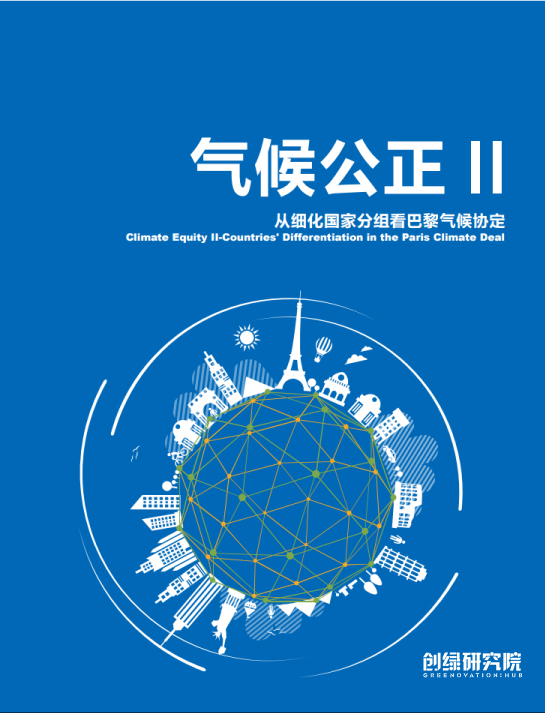
Download report:G:HUB_Countries' Differentiation in the Climate Deal_2015
The year 2015 is a critical period for international climate negotiation. At the 17th Conference of Parties (COP17) of the United Nations Framework Convention on Climate Change (UNFCCC) in 2011, countries agreed to establish the Durban Platform for Enhanced Action (ADP). The expectation for ADP is that COP21 (Paris, 2015) will agree on a new treaty that sets the rules for global cooperation on combating climate change after 2020. During the negotiation process for the post-2020 period, equity and justice have prevailed as the core elements.
As COP21 approaches, equity has garnered increasing attention from various parties. On the one hand, since COP15 in Copenhagen “bottom-up” and “pledge and review” have become the dominant paradigms in climate negotiation, as both provide flexible space for countries’ decision-making. Meanwhile, this has made the differentiation between developed countries and developing countries ambiguous. Developing countries, based on the consideration of their own development rights and needs, do not want to break down the dichotomic differentiation between developing and developed countries, as stipulated in the UNFCCC and Kyoto Protocol (KP) annexes, based on the principle of equity. Instead, they insist on strongly urging for continuity in such differentiation. The new climate treaty needs to respond to this divergence.
A better understanding of fairness in terms of effort sharing with quantifiable indicators could be useful to shed light on the fairness and adequacy of the Intended Nationally Determined Contribution (INDC), submitted by countries before the Paris meeting. Greenovation Hub believes that further differentiation of responsibilities among countries based on the existing classification can help advance understanding of the INDCs. During the current negotiation, countries could present detailed explanation on the equity of their proposed INDCs, including elaboration on the correspondence between national circumstances and their commitment to emission reduction.
The paper’s adherence to original annexes under KP recognizes the historical legacy of global climate negotiation, while further classification, based on the differentiated historical responsibility and capabilities of various countries, would serve as a response to the evolution of countries in terms of "Capability-Responsibility" during the past two decades. Through a review of representative proposals for further classification, including their indicator systems and related thresholds, Greenovation Hub finds that there is no significant difference among key emitters in terms of classification across different proposals.
Building on the existing research of others and Greenovation Hub’s understanding of climate equity, this paper also presents two classification proposals for further discussion. One is a per-capita “Responsibility-capability Index” with reference to the “Greenhouse Development Right Framework.” Under three scenarios (Scenario 1: 100% of responsibility, 550ppm; Scenario 2: 50% of responsibility + 50% of capability, 450ppm; Scenario 3: 100% of capability, 450ppm), the world’s 50 largest-emitting countries are ranked according to significant gap of values. The result shows that for major emitters there is no significant difference under different scenarios in terms of classification.
The other proposal, which is based on the framework put forward by Greenovation Hub in its previous Climate Equity report, analyzes the difference of countries in terms of "Capability-Need." The rationale of this framework is that countries at different development stages have different priorities in their development agendas. The difference between developed countries and less developed countries is not similar with the difference between underdeveloped countries and least developed countries. Such dissimilarity needs to be measured with an indicator system that is able to reflect the responsibility and capability attributes of both groups of countries in a differentiated and detailed manner, rather than with one single indicator system to make differentiation through threshold range. This classification method makes it easier to identify typical countries as representatives of different groups, meaning that other countries could align themselves with those typical countries by comparing national circumstances with them. That is to say, a country could choose its own group in which it has no qualitative difference with the corresponding typical country in terms of national circumstances. Yet, being in the same group does not mean making the same contributions, rather, countries’ contributions should reflect the quantitative differences they have with the typical country of the group.
After comparing classification results based on different methodologies, this research identifies five groups of relatively typical countries:
Group 1: Advanced countries, typically Australia, Canada, France, Germany, Japan, Norway, the U.S., etc.
Group 2: Less advanced/transitional countries, typically other Annex-I countries, mainly in Eastern Europe.
Group 3: Rich developing countries, typically Saudi Arabia, Singapore, South Korea, etc.
Group 4: Rapidly developing countries, typically Argentina, China, South Africa, etc.
Group 5: Underdeveloped countries, typically the least developed countries in Africa
This paper believes that the debate on nation classification will have following implications for the Paris climate deal:
1) Within the new international climate regime, due to a possible review mechanism, there is a window for countries to improve and enhance their Nationally Determined Contribution (NDC) - once the NDCs are adopted as part of the agreement, they will no longer be “intended.” The elements to be reviewed include equity, which means a country's elaboration on the equity aspect of its own contribution will also be "reviewed." Such elaboration needs to include two sets of relations, firstly, the correspondence between key national-circumstances indicators and development stages, and, secondly, the correspondence between different development stages and obligations of action.
2) For the relation between key national-circumstances indicators and development stages, the differentiation between different development stages is reflected in economic and technological development levels, and different historical responsibilities. Therefore, such differentiation should be described through appropriate indicators like capability, responsibility and real-development need.
3) The commitment or contribution of various countries under a new treaty of the Convention should correspond to different development stages (group of countries) in terms of form and quantity.
4) The first relation needs to be elaborated through an indicator system with equity considerations, while the second relation should be further refined based on the dichotomy in KP.
5) The clear elaboration of both relations in INDC, and other national explanatory documents, could help advance the process. On the one hand, it would help countries to understand the actions of each other and foster mutual trust and confidence in the climate regime before the Paris agreement; on the other hand, it would also provide a basic framework for “reviewing” the equity aspect among countries under the Paris climate agreement.
The research was independently conducted by the Greenovation Hub Policy Centre. During the period, it received guidance, support and encouragement from several experts, including Yang Fuqiang from the Natural Resources Defense Council; Chen Ying from the Research Center for Sustainable Development under the Chinese Academy of Social Sciences; Liu Qiang from the strategic planning division of the National Center for Climate Change Strategy and International Cooperation; and, Lu Mei and Wang Binbin from Oxfam Hong Kong’s climate change and poverty team. We are extremely grateful to all of them.
The world is so diverse with different development stages and cultural backgrounds that inform our understanding of equity. However, we believe that in order to seek a future with safe climate, we must look for our shared values and understandings, which will enable us to bridge our differences through communication, to reach a consensus to promote positive changes.
Related reports:



